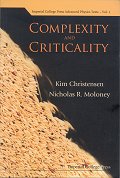Starting with percolation and the Ising model, the phenomenology of criticality is introduced. These equilibrium systems undergo a phase transition when external control parameters are finely tuned. The underlying theoretical formalism of criticality is carefully explained through the concepts of scale invariance, scaling functions, data collapse, and the renormalisation group transformation.
However, there are many examples in Nature of complexity, that is, the spontaneous emergence of criticality in slowly-driven non-equilibrium systems: earthquakes in seismic systems, avalanches in granular media and rainfall in the atmosphere. Key models of self-organised criticality illustrate how such systems may naturally evolve into a stationary state displaying scale invariance, and analogies are drawn between complexity and criticality.
The book includes a generous number of figures and exercises, and has an associated website containing solutions to exercises and animations of the models considered. The book is suitable for students at all levels, as well as researchers from fields outside physics and mathematics looking for an introduction to the ideas of complexity and criticality.
